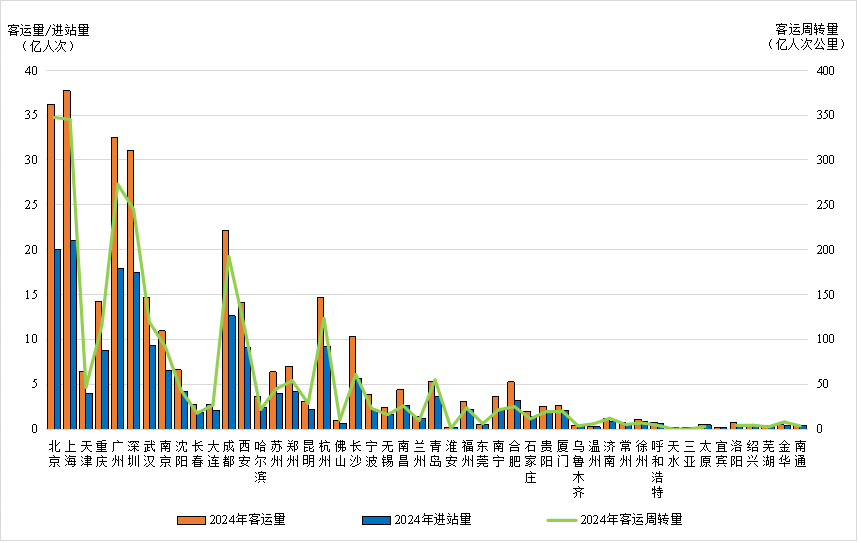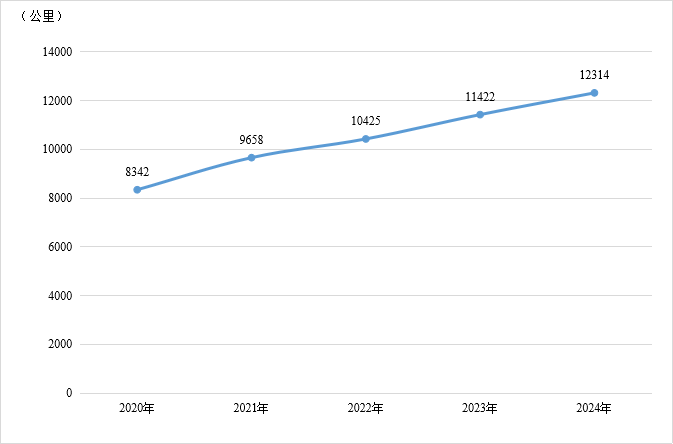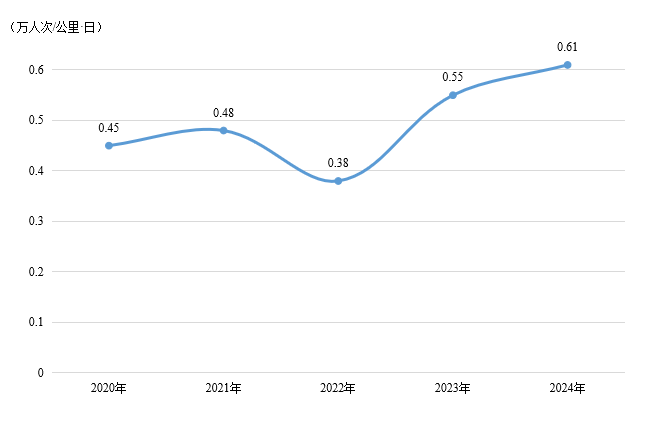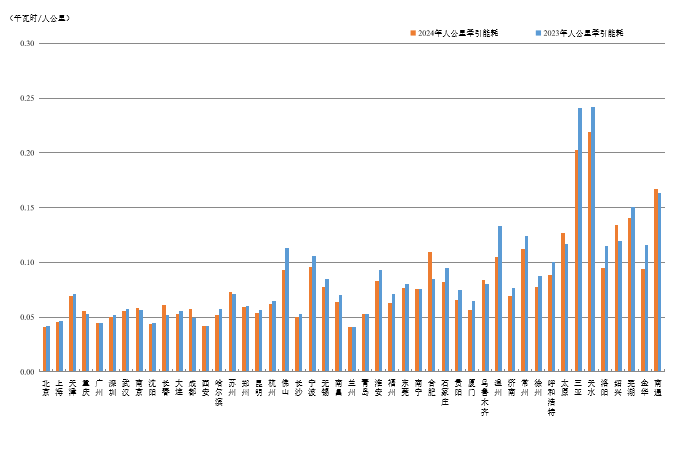
Reservation booth:+86(0)21-3114 8748
Visit/media contact:+8613601815988
QQ:2463282767
email:artsexpo@sgexpo.cn
Cities with urban rail: 58
Operating lines: 361
Total operating mileage: 12160.77 km
Net increase in operating mileage for the year: 936.23 km
Operational formats: 10 types
Total passenger traffic: 32.257 billion passengers
Passenger arrivals: 19.361 billion passengers
The total length of the line under construction: 5833.04 km
Completed construction investment: 474.941 billion yuan
In the past five years, the scale of the line put into operation has increased from 7,973.41 kilometers to 12,160.77 kilometers, an increase of 52.51%.
2020-2024 urban rail transit operating mileage


2024 urban rail transit operating line standard structure
By the end of 2024, a total of 23 cities in Chinese mainland have opened 54 fully automatic urban rail transit lines, forming a scale of 1484.43 kilometers of fully automatic operation lines, a year-on-year increase of 41.13%. In 2024, 421.94 kilometers of fully automatic operation lines will be opened. Among them, Xi'an has opened up to 3 lines, with an operating mileage of 100.46 kilometers.
In the scale of the total operating line network in the country, the scale of urban rail transit operation lines in the four major urban agglomerations accounts for nearly two-thirds. Urban rail transit is transforming from serving cities to serving urban agglomerations and metropolitan areas, and the effect of regional coordinated development is emerging.

Comparison of the scale of urban rail transit lines in major urban agglomerations in 2024
The total passenger volume exceeded 32 billion, a year-on-year increase of 9.47%.
The average daily passenger traffic in cities across the country reached 88.1345 million, a year-on-year increase of 8.06%.
The passenger turnover of urban rail transit was 264.473 billion person-kilometers, an increase of 7.92% over the same period of the previous year.

The passenger volume, inbound volume, and passenger turnover of urban rail transit in each city in 2024
Minimum departure interval and average operating service duration during peak hours
The minimum departure interval of urban rail transit peak hours is 276 seconds on average, and there are 16 lines that enter within 120 seconds.
The average operating service time of urban rail transit is 17.05 hours/day, and the average operating service time of Beijing is the longest at 18.73 hours/day.
Vehicle ownership and plan fulfillment rate
A total of 12,314 vehicles were allocated to urban rail transit nationwide, an increase of 892 over the previous year, an increase of 7.81%.
All 47 cities have a plan implementation rate of 100% or more.

The number of trains assigned to urban rail transit in China from 2020 to 2024
The average passenger intensity of urban rail transit in China was 6,100 person-times/km·day, and the passenger intensity increased by 00,600 person-times/km·day year-on-year, an increase of 10.25%.
The average passenger intensity of the large energy system (subway) is 7,600 person-times/km·day.

The average passenger intensity of urban rail transit in China from 2020 to 2024
The total electricity consumption of urban rail transit in China was 27.023 billion kWh, a year-on-year increase of 6.83%. Among them, the traction energy consumption was 14.150 billion kWh, a year-on-year increase of 8.26%.
The total electricity consumption per vehicle kilometer was 3.54 kWh, a year-on-year decrease of 0.42%.
The total electricity consumption per person-kilometer was 0.102 kWh, a year-on-year decrease of 1.34%.

In 2023-2024, the traction capacity of urban rail transit per person per kilometer in each city
In 2024, total CO2 emissions will increase by 6.83% year-on-year, CO2 emissions per vehicle-kilometer will decrease by 0.42% year-on-year, and CO2 emissions per person-kilometer will decrease by 1.34% year-on-year.
Based on the annual scale of construction and completed investment statistics in the past 10 years, the annual completed construction investment of urban rail transit in China has steadily increased since 2015, reaching its maximum in 2020 and then stabilizing and falling.
The scale of the line under construction in the past 10 years and the annual completed construction investment
33 urban express rail lines have been opened and operated, with an operating mileage of 1,597.25 kilometers, accounting for 13.13% of the operating mileage in mainland China.
The length of the lines under construction was 1536.39 kilometers, accounting for 26.34% of the total length of the lines under construction that year.
The urban express rail is mainly concentrated in the Yangtze River Delta, Pearl River Delta, Beijing-Tianjin-Hebei, Chengdu-Chongqing, Central Plains and other urban agglomerations to promote the integrated development of transportation.
After the release of the "Guidelines for the Development of Urban Rail Transit Integration in China", it has aroused strong repercussions in the industry. Wuxi Metro, CRRC Tangshan and other units subsequently issued their own integrated development guidelines.
Suggestions: First, publicize the concept of integrated development and promote the successful practice of integrated development. The second is to promote and guide enterprises to formulate action plans for integrated development, and encourage and promote the exploration and construction of diversified integration according to local conditions. The third is to continue to promote the construction of the "Wuxi Urban Rail Transit Diversified Integration and Sustainable Development Demonstration Project", and promote and share the practical results of integrated urban rail to the whole industry. Fourth, we will start the application for the integrated urban rail demonstration project in a timely manner, release a collection of typical cases of integrated urban rail, and deepen the construction of integrated urban rail from point to area.
After 60 years of development, China's urban rail transit industry has built the world's largest rail transit system, and its technology and management level have entered the forefront of the world, with remarkable achievements. At present, the industry is in a critical transformation stage from a "high-speed construction period" to a "operation-based period", in which the industry is facing challenges such as severe debt accumulation and rising operating costs.
In order to solve the financial dilemma, it is recommended to focus on seven tasks: first, planning and guidance, adapting to the comprehensive benefits of social economy; Second, the standard construction is appropriate, and the multimodal synergy is economical and applicable; the third is to select the best financing to alleviate the principal and interest expenses of debt; Fourth, it attracts passenger flow, and ticket revenue has risen steadily; Fifth, reduce expenditure and reduce costs, and reasonably control operating expenses; Sixth, diversified income generation, operating income to open up financial channels; Seventh, policy exploration and financial support.
By the end of 2024, 38 lines in 10 cities that have been in operation for more than 15 years will face the need for equipment renewal, and about 646 kilometers of lines will be in operation for more than 20 years (inclusive). In 2024, the "Guiding Opinions on the Transformation of Existing Lines of China's Urban Rail Transit" was released, proposing three types of transformations: "expiration (limited) renovation", "function improvement and transformation" and "extension and expansion transformation", aiming to strengthen the coordination and integration with relevant transportation systems and urban spaces, promote the overall improvement of line network functions, and achieve the purpose of eliminating potential safety hazards and improving operational efficiency, service quality, safety and reliability, and economic benefits.
The transformation of existing lines needs to solve the problems of financial pressure (over 10 billion yuan per year), technical adaptation and construction impact, and promote high-quality implementation through precise planning, independent technology, offline commissioning and differentiated strategies.
ESG is a corporate sustainability concept that focuses on the environment, society and governance. In 2024, the State-owned Assets Supervision and Administration Commission (SASAC) issued the "Building an ESG System with Chinese Characteristics" to promote the practice of SOEs in fulfilling their responsibilities and empower the construction of ESG systems with Chinese characteristics, emphasizing that SOEs need to closely follow national strategies (such as scientific and technological innovation and regional coordination) and highlight the functional value of energy protection and infrastructure.
Urban rail transit companies are facing important opportunities due to the high compatibility with ESG due to the characteristics of green travel and low-carbon technologies, but there are also challenges such as inconsistent information disclosure standards and insufficient localization exploration. It is recommended to build a multi-party collaboration platform, formulate industry ESG standards, integrate the supply chain evaluation system, strengthen talent training, regularly publish development reports, promote the sustainable transformation of the whole industry, and seize the opportunities of international market access.
Rail Transit Exhibition Booth Reservation
Rail Transit Exhibition Free registration for visit